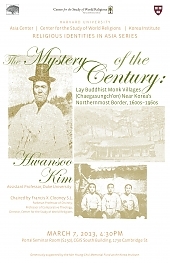Date:
Location:
Religious Identities in Asia Series

Hwansoo Kim
Assistant Professor, Duke University
Hwansoo Kim is an assistant professor at Duke University in the field of Korean Buddhism and culture with the departments of Religion and Asian & Middle Eastern Studies. He received his doctorate from Harvard University in 2007, followed by a post-doctoral appointment with the Harvard Reischauer Institute. He then taught Japanese religions as an assistant professor at the University of Arizona. Kim’s most recent article is “A Buddhist Christmas: The Buddha’s Birthday Festival in Colonial Korea (1928–1945).” He is the author of Empire of the Dharma: Korean and Japanese Buddhism, 1877–1912 (Harvard Asia Press, 2012).
Respondent: Francis X. Clooney, S.J., Parkman Professor of Divinity; Professor of Comparative Theology; Director of the Center for the Study of World Religions
Chaired by Sun Joo Kim, Harvard-Yenching Professor of Korean History; Director, Korea Institute, Harvard University
Abstract
A Japanese newspaper editorial from 1930s colonial Korea characterized the isolated villages of married Buddhist monks spread across the northern border between Korea and China as “the mystery of the century.” These lay monk villages (Chaegasŭngch’on) existed from the seventeenth century until the 1960s. The males in these villages shaved their heads and had wives and children, and their households ranged in number from thousands to tens of thousands at their peak. These lay monks and their families comprised the descendents of the Jurchens, an ethnic group from northern China who migrated to Korea and later mixed with Koreans.
In this presentation, based on previous scholarship and on untapped primary sources, I would like to take up two questions. First, how did these villagers come to take on a monastic identity (or, at minimum, the appellation)? Second, how should we understand the history of these communities within the context of Korean Buddhism? While scholars conventionally understanding the origin of this monastic identity as coincidental and unauthentic, I argue that Korean monks fleeing or relocating as a result of Chosŏn Korea’s anti-Buddhist policies perhaps contributed to the formation of a monastic identity of the males in these villages. Finally, I will address how the Neo-Confucian Chosŏn dynasty, the colonial government, and North Korean authorities politicized these communities for their own purposes.
Jointly sponsored with the Asia Center and the Center for the Study of World Religions
Generously supported by the Min Young-Chul Memorial Fund at the Korea Institute.